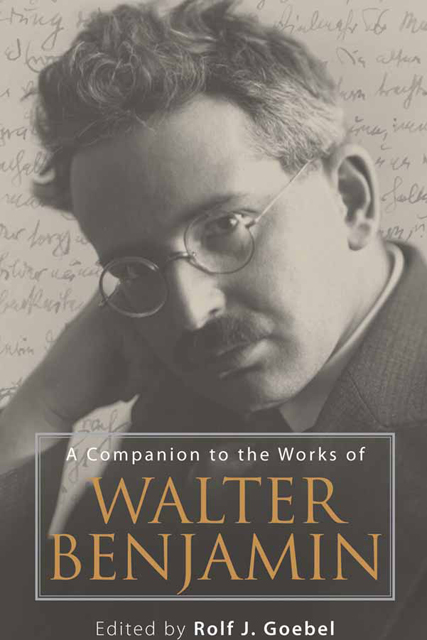Book contents
- Frontmatter
- Contents
- Preface
- Sources of Benjamin’s Works
- Chronology of Benjamin’s Major Works
- Introduction: Benjamin’s Actuality
- 1 Walter Benjamin's Criticism of Language and Literature
- 2 The Presence of the Baroque: Benjamin’s Ursprung des deutschen Trauerspiels in Contemporary Contexts
- 3 Lost Orders of the Day: Benjamin's Einbahnstraße
- 4 Literature as the Medium of Collective Memory: Reading Benjamin’s Einbahnstraße, “Der Erzähler,” and “Das Paris des Second Empire bei Baudelaire”
- 5 Benjamin in the Age of New Media
- 6 One Little Rule: On Benjamin, Autobiography, and Never Using the Word “I”
- 7 The Passagen-Werk Revisited: The Dialectics of Fragmentation and Reconfiguration in Urban Modernity
- 8 Benjamin’s Politics of Remembrance: A Reading of “Über den Begriff der Geschichte”
- 9 The Legacy of Benjamin’s Messianism: Giorgio Agamben and Other Contenders
- 10 Paris on the Amazon? Postcolonial Interrogations of Benjamin’s European Modernism
- 11 Benjamin’s Gender, Sex, and Eros
- 12 Sonic Dreamworlds: Benjamin, Adorno, and the Phantasmagoria of the Opera House
- Select Bibliography and List of Further Reading
- Notes on the Contributors
- Index
5 - Benjamin in the Age of New Media
Published online by Cambridge University Press: 28 February 2023
- Frontmatter
- Contents
- Preface
- Sources of Benjamin’s Works
- Chronology of Benjamin’s Major Works
- Introduction: Benjamin’s Actuality
- 1 Walter Benjamin's Criticism of Language and Literature
- 2 The Presence of the Baroque: Benjamin’s Ursprung des deutschen Trauerspiels in Contemporary Contexts
- 3 Lost Orders of the Day: Benjamin's Einbahnstraße
- 4 Literature as the Medium of Collective Memory: Reading Benjamin’s Einbahnstraße, “Der Erzähler,” and “Das Paris des Second Empire bei Baudelaire”
- 5 Benjamin in the Age of New Media
- 6 One Little Rule: On Benjamin, Autobiography, and Never Using the Word “I”
- 7 The Passagen-Werk Revisited: The Dialectics of Fragmentation and Reconfiguration in Urban Modernity
- 8 Benjamin’s Politics of Remembrance: A Reading of “Über den Begriff der Geschichte”
- 9 The Legacy of Benjamin’s Messianism: Giorgio Agamben and Other Contenders
- 10 Paris on the Amazon? Postcolonial Interrogations of Benjamin’s European Modernism
- 11 Benjamin’s Gender, Sex, and Eros
- 12 Sonic Dreamworlds: Benjamin, Adorno, and the Phantasmagoria of the Opera House
- Select Bibliography and List of Further Reading
- Notes on the Contributors
- Index
Summary
UPON ENTERING THE MAIN EXHIBITION venue of the 2007 Documenta in Kassel, visitors to the Fridericianum first encountered a rather unexpected sight: Paul Klee's 1920 painting Angelus Novus, famous mostly of course because of Walter Benjamin's penetrating interpretation of the work as an allegorical depiction of the melancholic angel of history, trying to pay tribute to what has been smashed in the catastrophic course of modern time. Klee's painting in fact is now inextricably bound to what Benjamin wrote about it in the last months of his life. To look at it is to hear Benjamin's voice; to cast our eyes onto the painting is to access the curious mixture of the messianic and the apocalyptic that structured Benjamin's late writing. There can be little doubt that the curators of Documenta sought to draw on this association. Klee's angel, in its Benjaminian reading, here was meant to offer a road map to show how to navigate the global array of contemporary art exhibited in Kassel. In this respect the painting took on the function of a natural sign, one whose meaning was given and granted, one that spoke to the viewer with unquestionable authority. Hung as it was in the main stairwell of the Fridericianum, Angelus Novus served as a signifier providing its own interpretation and hence was in no need of further reading — a sign asking the viewers to subject their interpretative freedom to a set of preordained meanings similar to the way in which we allow a street map to guide us through a city without (at least initially) questioning its referential accuracy.
Any visitor, however, who stepped closer to Klee's painting and read the adjacent label was in for a surprise. For here is what the label read: “Paul Klee / Angelus Novus, 1920 / Ausstellungskopie | exhibition copy / Fotografie | Photograph: David Harris.” Rather than presenting the real thing and inviting the audience to be absorbed by the originality of Klee's brushstroke, the curators openly admitted to having violated customary exhibition practices and offered a mere duplicate to the beholder's eye. While there may have been many good logistical reasons for not displaying the original, it is more than tempting to understand the curators’ intervention as both a systematic and symptomatic gesture. In his essay “Das Kunstwerk im Zeitalter seiner technischen Reproduzierbarkeit” (“The Work of Art in the Age of Its Technological Reproducibility,” 1935; third version, 1936–39) Benjamin argues that the media of technological reproduction, such as photography and film, destroy the “aura,” that is, the traditional artwork's quasi-sacred halo of originality and uniqueness. In so doing, Benjamin argues, film instigates a new, emancipatory way of seeing, which helps viewers to recognize the spectacular self-representations of Fascism, defined by Benjamin as a new and false aestheticization of politics in mass rallies, the cult of the Führer, and other such “auratic” effects of mass manipulation. As if bringing into play Benjamin's own valorization of mechanical reproduction over the auratic nature of the original work of art, the curators here, alluding to Benjamin's essay, seemed to empower the visiting masses “des Gegenstands aus nächster Nähe im Bild, vielmehr im Abbild, in der Reproduktion, habhaft zu werden” (GS I.2:479; “to get hold of an object at close range in an image, or, better, in a facsimile, a reproduction,” SW 4:255), at the expense of being captured by the spell of originality and uniqueness.
- Type
- Chapter
- Information
- A Companion to the Works of Walter Benjamin , pp. 112 - 129Publisher: Boydell & BrewerPrint publication year: 2009



